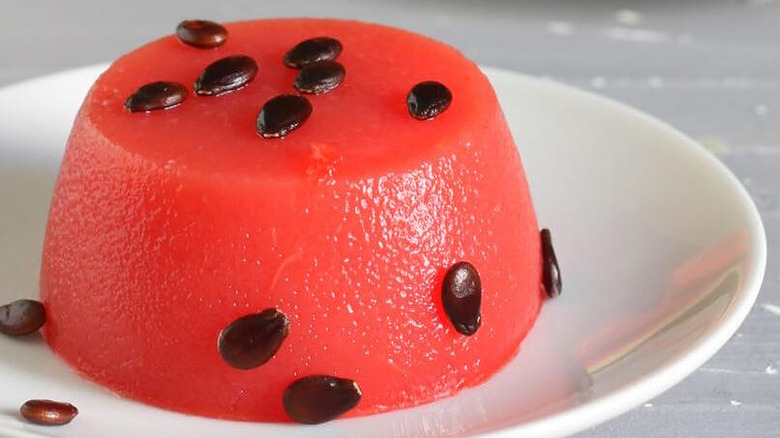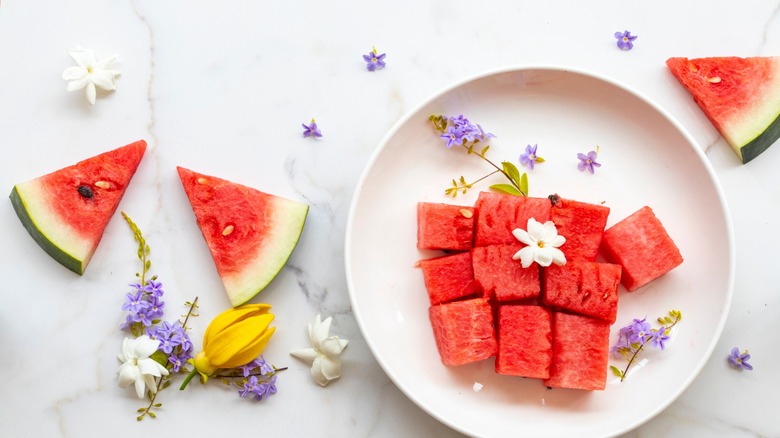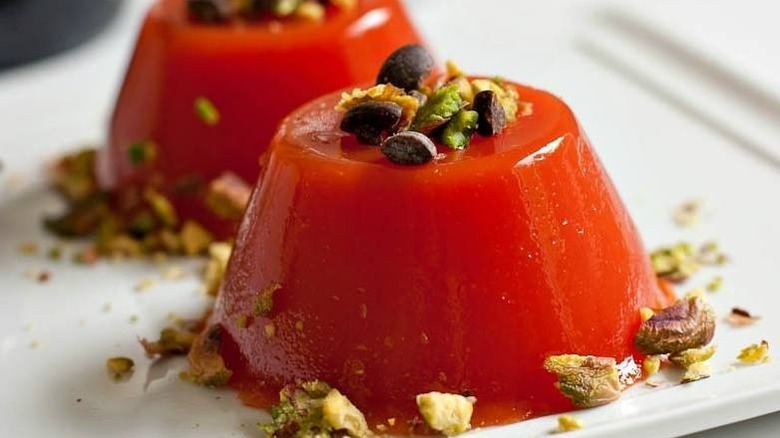The Lush Sicilian Dessert That Pairs Watermelon And Jasmine Flowers
Watermelon is a refreshing, satisfying summer dessert to snack on, a nice way to sit on an outdoor patio and digest grilled meats as a hot day starts to wind down. Sometimes, though, you may feel like something a bit more, well, dessert-y. Enter gelo di melone, the Sicilian watermelon pudding that combines the restorative juiciness of the fruit with the fluffy consistency of custard. Add some delicate floral notes of jasmine flowers and the nutty crunch of pistachio shavings and you've got yourself one feel-good ending to a barbecue. If you've heard of Palermo's u' gelu ri muluni, it's a close cousin.
Gelo di melone is rooted in the ninth-century Islamic conquest of Sicily and combines Italian and Arab ingredients and cooking styles, reflecting the unique cultural crossroads of the island. Jasmine flowers and pistachio nuts, common flavorings in the cuisines of the Levant, point towards the diverse origins of the dish. The dessert is often a part of summertime celebrations like the mid-August holiday of Ferragosto and U Festino, the Feast of Santa Rosalina in mid-July. However, there's nothing wrong with enjoying gelo di melone at any time of the year, though there may be a spike in off-season watermelon prices.
Thickening your watermelon
Transforming a solid watermelon into a luscious pudding may sound like a work of alchemy, but the actual recipe isn't all that complicated. First, you have to extract the juice from the watermelon. If you don't have a juicer, you can just blend some up and pour the pureed mass over a sieve to separate the liquid from the pulp (a mixer or pretty much anything else that can mash the watermelon up also works for this).
After this comes the cornstarch, the essential magic ingredient that thickens the watermelon juice. Alternatives include potato starch, which some say gives a smoother texture, wheat starch, which some traditional Italian recipes call "amido di frumento," and gelatin, which will result in a bouncier texture closer to jelly than pudding. It's also important to note that there isn't one definitive ratio of juice to thickener; it all depends on personal preference. Just remember to not mix the two all at once. You'll start off by adding cornstarch to about a quarter of the watermelon juice, then simmer the remaining supply with sugar, jasmine, and whatever other flavorings you want to include. Vanilla and cinnamon, by the way, happen to be excellent choices.
The joy of gelo di melone
Once you've simmered the flavoring base, you can pour in the watermelon-corn starch slurry and whisk for two or three minutes under low heat until the mixture thickens a bit. Bust out the sieve again to strain the concoction a second time, removing any clumps of starch, flower petals, or any other additives like cinnamon sticks or cloves to make your Gelo as silky smooth as possible. Here is where you'll start chilling and solidifying your pudding, so pick out your funnest, favoritest molds and start pouring. Individual servings in smaller cups will probably look nicer and hold the liquid better, but feel free to use a whole bowl.
The ground pistachios come in at the very end as a garnish — once you've let your creation sit in the fridge for two or three hours. You'll know once the starch has set in and there's a bit of resistance when poking it with a fork or finger. Another essential topping is chocolate chips, a representation of watermelon seeds that also happen to add an extra kick of sweetness. It's light; it's refreshing — it's gelo de melone!



